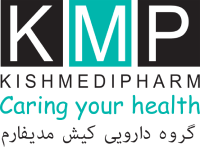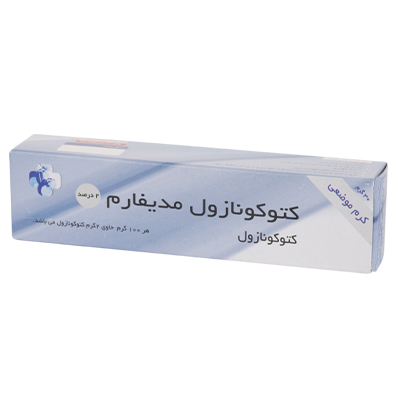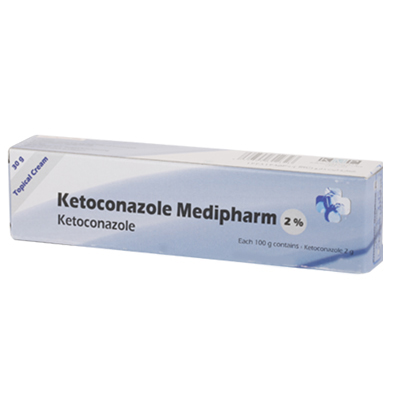Description
Ketoconazole is an antifungal drug that treats infections caused by fungi. This drug is produced and offered worldwide in oral, vaginal, and topical forms. One of the most famous products of Kish Medipharm Pharmaceutical Company is Ketoconazole Medipharm topical cream. This drug is formulated in a tube in the form of a cream and with a dosage of 2%.
The mechanism of action of ketoconazole is that by inhibiting ergosterol biosynthesis, it destroys the fungal cell wall and changes its permeability, leading to the loss of essential intracellular elements for growth and inhibition of fungal proliferation.
Benefits of Ketoconazole Cream
As stated, this product is used topically on the affected area only, which is the most important advantage of Medipharm Ketoconazole topical cream. Topical products have fewer side effects since they have less systemic absorption and are often applied to the affected area. Other advantages of Ketoconazole topical cream include low cost, easy use, no dependence or addiction, local soothing, and suitability for the elderly.
Uses of ketoconazole topical cream
As we have previously stated, Ketoconazole topical cream is considered an antifungal, antiandrogen, and antiglucocorticoid drug. The uses of Ketoconazole cream are as follows:
- Tinea pedis, or athlete's foot, also known as athlete's foot, affects the skin of the feet and is highly contagious. Remember to follow hygiene tips, especially in gyms and public environments. It is better not to use other people's personal items. Wear breathable shoes. Strengthen your immune system, because people with weak immune systems and a history of diabetes and eczema are more likely to suffer from this skin condition. Constantly changing socks and using cotton socks can be ways to prevent this disease. If you have a fungal infection of the feet, ketoconazole cream can help treat this condition.
- Psoriasis: A fungus called Pityrosporum orbicularis lives in the human body, and when it overgrows and causes psoriasis, it can be treated with topical ketoconazole cream. This medication helps reduce the growth of the fungus, reducing redness and inflammation of the skin. It is possible that the duration of treatment for this skin condition with topical ketoconazole cream will take several weeks to several months. Therefore, consulting an infectious disease specialist and a dermatologist can help you decide how and how much to take this medication.
- Candidiasis is a fungal skin infection that manifests with symptoms such as blistering, redness, inflammation and cracking of the skin and is caused by an overproduction of Candida. Candida is generally found in the mouth, digestive tract and skin, but in these conditions it is produced in excess. Using ketoconazole cream can prevent the recurrence of this disease and reduce the complications caused by candidiasis. It should be noted that people with underlying diseases such as HIV and AIDS are more likely to experience such problems than other people.
- Seborrheic dermatitis is a type of fungal skin infection that most commonly appears on the head, face, and chest. It causes scaling, swelling, redness, and itching. It is more common in people with AIDS, hepatitis, and epilepsy. Seborrheic dermatitis can be treated and improved with topical ketoconazole cream.
- Tinea versicolor (dermatophytosis of the trunk) and inguinal ringworm (dermatophytosis of the groin) are caused by fungi called Trichophyton and Epidermophyton floccosum and cause symptoms such as redness, scaling, and itching on the trunk and groin. To prevent this condition, you should follow hygiene tips and use a separate towel. Avoid contact with people with this disease until the skin problem improves. In case of tinea versicolor and inguinal ringworm, you can use topical ketoconazole cream for a few weeks to a few months with the diagnosis of a specialist. It should be noted that this medicinal product is not useful for all people with tinea versicolor and inguinal ringworm, and there is a possibility of replacing it with another medicine as diagnosed by a specialist.
- Dermatophytosis of the beard or tinea barba, which usually occurs on the chin, neck and beard, is treated with ketoconazole cream. This disease is caused by an overgrowth of a fungus called Trichophyton. To prevent this condition, try to maintain personal hygiene and be sure to disinfect your razors. Do not use the equipment of people with this disease. Try to avoid contact with people in hot and humid public environments such as swimming pools, saunas and jacuzzis, and be sure to wash your body well with hygiene products and dry it completely. Remember that topical ketoconazole cream is not always suitable for all people with dermatophytosis of the beard.
- Tinea versicolor, or pityriasis versicolor, is usually caused by excessive sweating, genetics, hot and humid weather, and a weakened immune system. This skin condition is a type of skin fungus that occurs when the Malassezia fungus overgrows. Tinea versicolor is characterized by itching, skin discoloration, and white, pink, red, and brown scales. Tinea versicolor usually improves or disappears completely after a few weeks with topical ketoconazole cream. Maintaining personal hygiene, having personal items and washing them regularly, wearing cotton clothes, and changing them frequently can be considered ways to prevent this skin problem.
- Onychomycosis or fungal nail infections are characterized by symptoms such as nail discoloration (brown, black, or yellow), nail thickness changes (thinning or thickening), pain and swelling, loss of shine, and nail peeling. Dermatologists and infectious disease specialists usually recommend the use of ketoconazole cream to treat this condition. This problem occurs in the fingernails and toenails, and its causes can include trauma to the nails, contact with the environment and people with this nail problem, and having underlying diseases such as AIDS and hepatitis. Using topical ketoconazole cream kills the fungi that cause onychomycosis and improves the appearance of the nails.
Side effects of ketoconazole topical cream
Although topical ketoconazole cream is used to treat many fungal infections, it is not recommended for everyone and can cause unwanted side effects. If these side effects worsen or become more severe, be sure to see a specialist or emergency room immediately. These side effects are usually caused by drug interactions, sensitivity to the product's ingredients, age, gender, and physical health conditions. The most common side effects of topical ketoconazole cream include:
- Hormonal disorders including: menstrual irregularities, decreased testosterone and sperm production
- Depression and extreme distress (suicidal tendencies)
- Skin rash, itching, redness, inflammation, and swelling of the skin
- Dizziness and headaches, vision problems and decreased vision
- Arrhythmia or irregular heartbeat
- Dark urine or light stools
- Diarrhea and vomiting
Recommended uses for Ketoconazole cream
One of the most important parts of the brochure and the writings on the medicine boxes are usually the sections on recommendations and warnings. Observing these obvious points and being aware of them can be of great help to the consumer. Consulting with a pharmacist when buying medicine is another way to increase awareness of the medicine you are using. Below are some of the points that you should always keep in mind while using ketoconazole topical cream:
- People who are allergic to miconazole or other imidazole drugs may also be allergic to ketoconazole cream, so if you have a history of allergies to these drugs, consult your doctor.
- If there is no improvement after 2 to 6 weeks of starting treatment with topical ketoconazole cream, inform your doctor.
- If you miss a dose of ketoconazole cream, take it as soon as you remember, but if it is almost time for your next dose, take the medicine as usual and avoid doubling the dose.
- In patients with athlete's foot, after washing between the toes, the area should be carefully dried before applying topical ketoconazole cream. After bathing, avoid wearing wool or synthetic socks, and wear clean cotton socks and change them daily. Also, wear sandals and breathable shoes.
- To prevent reinfection, use topical ketoconazole cream as directed by your doctor.
- Ketoconazole cream is for external use only and should be avoided with mucous membranes, including the eyes, mouth, and nose.
Conclusion
Topical ketoconazole cream is an antifungal that is used to treat and improve diseases such as athlete's foot, nail fungus, some types of psoriasis, tinea versicolor, tinea inguinale, and tinea versicolor. Maintaining personal hygiene prevents the occurrence of many of the aforementioned diseases. Ketoconazole cream can be purchased and purchased at pharmacies nationwide with a prescription from a specialist. The area is covered with this medicinal product throughout the day and this medicine is usually not used more than 2 to 3 times.
Remember, all of the above is for the reader's information only and does not mean that it is preferred by a specialist. Your doctor will definitely prescribe the appropriate medication after examining your condition.



Reviews
There are no reviews yet.